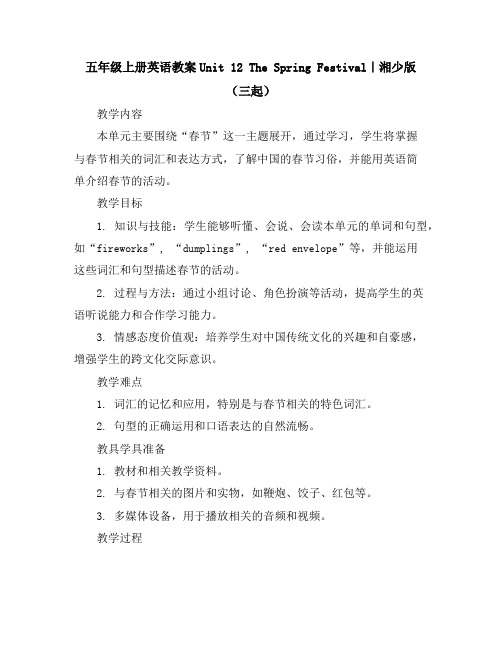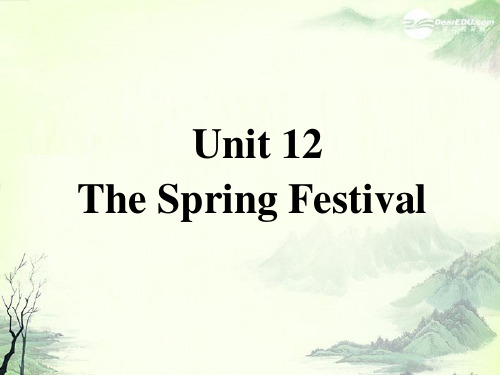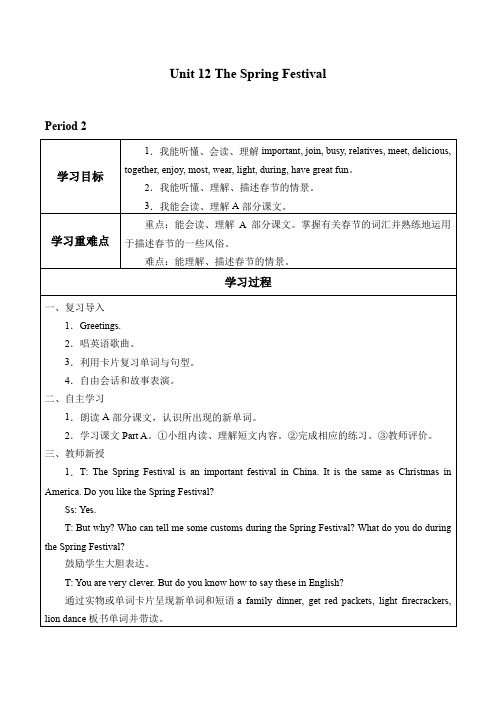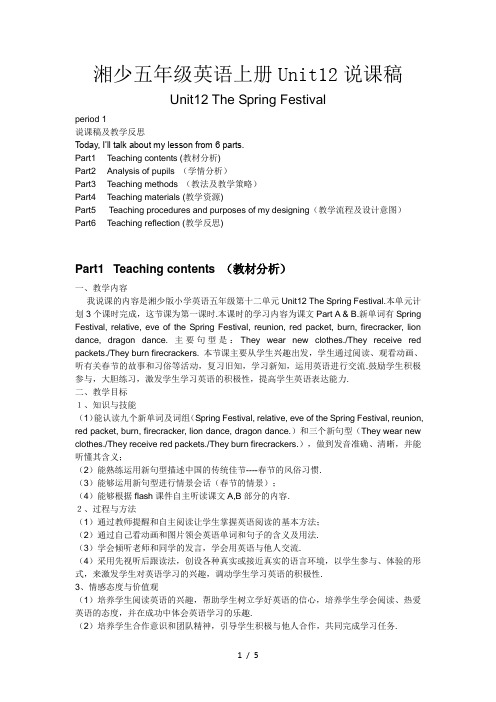湘少版五年级英语上册Unit 12(2)导学案
- 格式:xls
- 大小:26.00 KB
- 文档页数:2

五年级上册英语教案Unit 12 The Spring Festival|湘少版(三起)教学内容本单元主要围绕“春节”这一主题展开,通过学习,学生将掌握与春节相关的词汇和表达方式,了解中国的春节习俗,并能用英语简单介绍春节的活动。
教学目标1. 知识与技能:学生能够听懂、会说、会读本单元的单词和句型,如“fireworks”, “dumplings”, “red envelope”等,并能运用这些词汇和句型描述春节的活动。
2. 过程与方法:通过小组讨论、角色扮演等活动,提高学生的英语听说能力和合作学习能力。
3. 情感态度价值观:培养学生对中国传统文化的兴趣和自豪感,增强学生的跨文化交际意识。
教学难点1. 词汇的记忆和应用,特别是与春节相关的特色词汇。
2. 句型的正确运用和口语表达的自然流畅。
教具学具准备1. 教材和相关教学资料。
2. 与春节相关的图片和实物,如鞭炮、饺子、红包等。
3. 多媒体设备,用于播放相关的音频和视频。
教学过程1. 导入:通过展示春节的图片和视频,引导学生谈论他们对春节的了解和感受。
2. 新课呈现:教授本单元的单词和句型,通过图片、实物和情景模拟等方式,帮助学生理解和记忆。
3. 练习:通过小组讨论、角色扮演等活动,让学生练习本单元的单词和句型。
4. 巩固:通过游戏、竞赛等活动,巩固学生对本单元单词和句型的掌握。
板书设计1. Unit 12 The Spring Festival2. 单词列表:fireworks, dumplings, red envelope, etc.3. 句型:We have fireworks during the Spring Festival. We eat dumplings during the Spring Festival. We receive red envelopes during the Spring Festival.作业设计1. 抄写本单元的单词和句型。


五年级上册英语教案-Unit 12 The Spring Festival 第二课时
湘少版(三起)
教学目标
•知道什么是春节。
•能够运用本课所学到的英语单词和语句来表达与春节有关的事情。
•能够熟练朗读课文。
教学重点
•让学生了解春节的传统习俗和节庆活动。
•培养学生的英语阅读和口语表达能力。
教学难点
•让学生在理解春节文化的基础上,运用英语表达这些文化。
教学准备
•PPT幻灯片
•课堂教具:贴纸、墨水笔、笔记本
教学步骤
1.引入
在教师简单介绍春节相关文化之后,向学生展示幻灯片“The Spring Festival”。
2.阅读
教师为学生播放口语课文相关部分的音频,让学生仔细听一遍,并配合幻灯片上的图片来理解课文。
3.理解
询问学生对于春节这个节日是否有了更多的了解,在学生逐渐充实了知识储备后,教师提示学生请注意贴纸背面的中英文图案和左侧的英文单词,让学生在理解中收集并摆放贴纸。
4.交流
让学生在根据贴纸上的英文单词介绍中国文化习俗时,跟同学交流,分享和更正信息。
5.输出
提醒学生总结春节文化,并让其利用笔记本对所学英文做一些记录。
课后作业
•默写本课时需要掌握的英文单词,并尝试用英语介绍春节节日文化。
•做一次测验以更好地掌握本节课所涉及的知识内容。
总结
通过本课中对于中国文化习俗的介绍和学习,学生们增加了对于春节的了解,提高了英语口语表达和阅读的技巧,更为全面地认知了中国这个千年古国的文化背景。

新版湘少版五年级英语上册教案(全册共48页)新版湘少版五年级英语上册教案(全册共48页)⽬录Unit 1 I’d like a cold drinkUnit 2 Do you want some rice?Unit 3 Can I borrow a pencil?Unit 4 Can I have a puppy?Unit 5 Which one do you want?Unit 6 I like sweets.Unit 7 Do you have any hobbies?Unit 8 What time do you get up?Unit 9 My father helps me.Unit 10 What does that sign mean?Unit 11 We are sorry.Unit 12 The Spring FestivalUnit 1 I’d like a cold drinkTeaching aims:1. Knowledge aimsLearning the new words and sentences just like cold drink/ bun/ feel hungry/ I’d like a cold drink./ would you like some buns?/I feel hungry and so on.2. Ability aimsImprove the students oral English and let students know something about like or dislike something, know some words of things and drink and so on.Let the students can make communication with each other.3. Moral aimsWe must attend the class seriously.Teaching methods:Reading. /Listening. /Talking. /Singing.Play Games.Making actions.Teaching aids:a tape recorder / brushMain points and difficulties:New wordsExpressions and sentencesPeriod 1Step 1. Revision1. Greetings.Good morning. /Afternoon everyone. / How are you? /Who is on duty today? What’s the weather like today?2. What fruit/food/drink do you like?Step 2.Presetation1. Have a match between boys and girls, to see who can say out more fruits/drink words.Learn the new words and phrases: cold drink/ feel/ hungry/ bun/ help.T take an apple and ask: would you like an apple? Help Ss answer the question in this way: Yes, I’d like one./ No, thank you. Ask Ss practice the dialogue with other things.Step 3. Drills1. Listen to the tape.2. Read after the tape.3. Read out the words and sentences according to the computer.Check up the result.Act the text.Step 4. Exercise1. Remember the words.2. Read Part A after class.Period 2Step 1. Revision1. Greetings.Good morning. /Afternoon everyone. / How are you? /Who is on duty today?2. Go over the words and sentences in part A and B.Step 2.Presetation1. Show some cards of food and fruits and ask Ss look and say out the words quickly. Make sentences according to the pictures giving. Can use the sentences learnt last class.Learn to say the sentence pattern:Do you have any drink/fruit cards?Yes, I have. / No, I don’t.Step 3. Practice:1. Draw and make the cards.Play the cards game.Ask and find the cards, which can collect the whole cards of one thing, who can win the game.3. Read out the words and sentences according to the computer.4. Check up the result.Step 4. Exercise1. Remember the words.2. Read Part A after class.Period 3Step 1. Greetings and RevisionT: Class begins.S: Stand up. Good morning/afternoon teacher.T: Good morning/afternoon. Sit down please.S: Thank you!Revision.1. Words: feel hungry /cold drink /bun /buy /water /soup /vegetables /breakfast /lunch /pepper /salt /forget /remember/tomorrow /borrow2. Sentences: I’d like some cakes/buns/…. Would you like …?I’m hungry, I’d like ….3. Understand the text of part D.4. Lead the students to finish the exercise in part E and F..Step 2. Presentation.1. Learn Part D: ask Ss the text by themselves, find out the new words and sentences. Ask student to explain the meaning of the text.Finish the exercises.Step 3. Drills1. Read Part D after the teacher.2. Prates by themselves.3. Look at the pictures and finish part F.Step 4. Exercises1.Do the exercises book’s Pa rt C and part DTry their best to recite A and B.Unit 2 Do you want some rice?Teaching aims:1. Knowledge aimsLearning the new words and sentences just like water / soup/ vegetables/ breakfast/supper/lunch/pepper/salt/ Do you want some soup? /Yes, please./No, thank you.2. Ability aimsImprove the students oral English and let students know something about like or dislike something, know some words of food.Let the students can make communication with each other.3. Moral aimsWe must attend the class seriously.Teaching methods:Reading. /Listening. /Talking. /Singing.Play Games.Making actions.Teaching aids:a tape recorder / brushMain points and difficulties:New wordsExpressions and sentencesPeriod 1Step 1. Revision1. Greetings.Would you like to say “hello” to you friends?2. What food do you like?Step 2. Presentation1. Have a match between boys and girls, to see who can say out more fruits/drink/foodwords. Learn the new words and phrases: water / soup/ vegetables/ breakfast/supper/lunch/pepper/saltT take an apple and ask: Do you want an apple? Help Ss answer the question in this way: Yes, please/ No, thank you. Ask Ss practice the dialogue with other things.Step 3. Drills1. Listen to the tape.2. Read after the tape.3. Read out the words and sentences according to the computer.Check up the result.Act the text.Step 4. Exercise1. Remember the words.2. Read Part A after class.Period 2Step 1. Revision1. Greetings.Good morning. /Afternoon everyone. / How are you? /Who is on duty today?2. Go over the words and sentences in part A and B.Step 2.Presetation1. Show some cards of food and fruits and ask Ss look and say out the words quickly. make sentences according to the pictures giving. Can use the sentences learnt last class.learn to say the sentence pattern:Do you want some salt?Yes, please.No ,thank you.Step 3. Practice:1. Draw and make the cards.Play the cards game.Ask and find the cards, who can collect the whole cards of one thing, who can win the game.3. Read out the words and sentences according to the computer.4. Check up the result.Step 4. Exercise1. Remember the words.2. Read Part A after class.Period 3Step 1. Greetings and RevisionT: Class begins.S: Stand up. Good morning/afternoon teacher.T: Good morning/afternoon. Sit down please.S: Thank you!Revision.Words: water / soup/ vegetables/ breakfast/supper/lunch/pepper/salt2. Sentences: Do you want some rice?Yes, please.No, thank you.3. Understand the text of part D.4. Lead the students to finish the exercise in part E and F..Step 2. Presentation.1. Learn Part D: ask Ss the text by themselves, find out the new words and sentences. Ask student to explain the meaning of the text.Finish the exercises.Step 3. Drills1. Read Part D after the teacher.2. Precise by themselves.3. Look at the pictures and finish part F.Step 4. Exercises1. Do the exercises book’s Part C and part DTry their best to recite A and B.Unit 3 Can I borrow a pencil?Teaching aims:1. Knowledge aimsLearning the new words and sentences just like borrow /thing /schoolbag /forget /bring /remember /tomorrow /Can I borrow a pencil? /Can I have a pencil? /You’re welcome. /draw a line. /clean the blackboard and so on.2. Ability aimsImprove the students oral English and let students know something about borrow /thing /schoolbag /forget /bring /remember /tomorrow /Can I borrow a pencil? /Can I have a pen cil? /You’re welcome. /draw a line. /clean the blackboard and so on. Let the students can make communication with each other.3. Moral aimsWe must attend the class seriously.Teaching methods:Reading. /Listening. /Talking. /Singing.Play Games.Making actions.Teaching aids:a tape recorder /comb/brushMain points and difficulties:New wordsExpressions and sentencesTeaching steps:Period 1Step 1. Revision1. Greetings.Good morning. /Afternoon everyone. / How are you? /Who is on duty today?2. Go over lesson 2.Step 2. Presentation1. Turn on the computer and learn the words according to the pictures: forget /remember /tomorrow /borrow /bring /thing/brush2. Learn the sentences according to the words and pictures: Can I borrow a pencil, please? /Can I have a pencil, please? /what do you want? /You’re welcome.Step 3. Drills1. Listen to the tape.2. Read after the tape.3. Read out the words and sentences according to the computer.4. Check up the result.Step 4. Exercise1. Remember the words.2. Read Part A after class.Period 2Step 1. Revision1. Greetings.Good morning. /Afternoon everyone. / How are you? /Who is on duty today?2. Go over lesson 2.Step 2.Presetation1. Turn on the computer and learn the words according to the pictures: forget /remember /tomorrow /borrow /bring /thing /brush2. Learn the sentences according to the words and pictures: Can I borrow a pencil, please? /Can I have a pencil, please? /what do you want? /You’re welcome.Step 3. Drills1. Listen to the tape.2. Read after the tape.3. Read out the words and sentences according to the computer.4. Check up the result.Step 4. Exercise1. Remember the words.2. Read Part A after class.。


湘少五年级英语上册Unit12说课稿Unit12 The Spring Festivalperiod 1说课稿及教学反思Today, I’ll talk about my lesson from 6 parts.Part1 Teaching contents (教材分析)Part2 Analysis of pupils (学情分析)Part3 Teaching methods (教法及教学策略)Part4 Teaching materials (教学资源)Part5 Teaching procedures and purposes of my designing(教学流程及设计意图)Part6 Teaching reflection (教学反思)Part1 Teaching contents (教材分析)一、教学内容我说课的内容是湘少版小学英语五年级第十二单元Unit12 The Spring Festival.本单元计划3个课时完成,这节课为第一课时.本课时的学习内容为课文Part A & B.新单词有Spring Festival, relative, eve of the Spring Festival, reunion, red packet, burn, firecracker, lion dance, dragon dance. 主要句型是:They wear new clothes./They receive red packets./They burn firecrackers. 本节课主要从学生兴趣出发,学生通过阅读、观看动画、听有关春节的故事和习俗等活动,复习旧知,学习新知,运用英语进行交流.鼓励学生积极参与,大胆练习,激发学生学习英语的积极性,提高学生英语表达能力.二、教学目标1、知识与技能(1)能认读九个新单词及词组(Spring Festival, relative, eve of the Spring Festival, reunion, red packet, burn, firecracker, lion dance, dragon dance.)和三个新句型(They wear new clothes./They receive red packets./They burn firecrackers.),做到发音准确、清晰,并能听懂其含义;(2)能熟练运用新句型描述中国的传统佳节----春节的风俗习惯.(3)能够运用新句型进行情景会话(春节的情景);(4)能够根据flash课件自主听读课文A,B部分的内容.2、过程与方法(1)通过教师提醒和自主阅读让学生掌握英语阅读的基本方法;(2)通过自己看动画和图片领会英语单词和句子的含义及用法.(3)学会倾听老师和同学的发言,学会用英语与他人交流.(4)采用先视听后跟读法,创设各种真实或接近真实的语言环境,以学生参与、体验的形式,来激发学生对英语学习的兴趣,调动学生学习英语的积极性.3、情感态度与价值观(1)培养学生阅读英语的兴趣,帮助学生树立学好英语的信心,培养学生学会阅读、热爱英语的态度,并在成功中体会英语学习的乐趣.(2)培养学生合作意识和团队精神,引导学生积极与他人合作,共同完成学习任务.(3)通过本课的学习,使学生明白中国传统佳节-----春节的一些风俗习惯,感受春节的气氛,树立热爱大家庭思想观.三、教学重难点教学重点:描述春节的情景.教学难点:掌握与春节有关的词汇.Part2 Analysis of pupils (学情分析)1、学生经过了两年的英语学习,有了一定英语基础.2、学生课前已经学习与本单元内容有关的知识:本单元可以说是一个整合,因为第一次出现了大篇文章的阅读形式,而里面又包含了学生学过的很多知识,如现在进行表将来时,比较级和最高级,各种常用句型等.当然也有新知识的呈现,比如有关春节要用到的词汇.这样设计非常巧妙,既能起到复习的作用,又能符合马上放寒假过春节的阶段特点.学生已经学习了spring, festival, lion, dance.dragon, family,red等单词3、学生能听懂会说,完成相关情感目标,并能在实际情景中运用.根据学生已学知识来看,学生有能力接受和学习本单元的教学内容,也符合学生的认知特点.4、五年级的学生,生性活泼好动,思维活跃,喜欢直观形象思维,对动画、表演特别感兴趣.善于与同学交流,乐于表达自己,渴望得到同学和教师的赞许.5、学生对英语学习的兴趣还较为浓厚,听说读写演的能力已有了一定程度的发展,但随着知识点难度的加大兴趣逐渐在减弱,说写能力还有待加强.6、学生对于Flash动画的呈现形式感到很好奇,尤其是交互可参与式的.Part3 Teaching methods (教法及教学策略)本节课所采用的教学方法为听说法、视听法、任务型教学法及交际法.具体教学策略如下:1、多媒体直观示范策略:通过多媒体集视、听、说为一体的优势,让学生感悟单词及句型,理解其含义;2、自主学习策略:学生通过听录音的形式自主学习课文,把英语课堂真正地还给学生,培养学生良好的自主学习的习惯;3、合作学习策略:学生两人之间或六人之间合作学习,在真实的语境中提高学生的英语口语能力;4、游戏激趣策略:运用学生多样的英语游戏,营造轻松、愉悦的英语教学氛围,让学生在“玩中学、学中玩”.Part4 Teaching materials (教学资源)1、湘少版小学英语五年级上册教材.2、CAI课件.3、贴对联,吃团圆饭,舞龙,舞狮,放鞭炮的图片各一张.4、与课文相关的Flash动画.5、学生和老师准备各种物品,如红包,几个小鞭炮等.6、教学环境:多媒体教室、教学课件(PPT形式,内含图片、flash )Part5 Teaching procedures and purposes of my designing (教学流程及设计意图)这部分是我说课的重点.Step 1 Warm up热身1、Greetings(师生问候)T:Now! Class begins!S: Stand up, please.T: Good morning,boys and girls. Nice to meet you.Ss:Nice to meet you, too.T: Are you happy today?Ss: Yes, we are happy.2、Free talk:T alk about the Festival, day and the date.T: What day is it today?S1: It’s Saturday.T: What’s the date today?S2: ...【设计意图】谈论星期和日期为要新授的The first day of the first lunar month即春节日期作铺垫.Step 2 Presentation新课呈现1、出示春联:T:Now, What’s this?Ss: 春联T:Do you know when you put them on your door?引导学生回答.Ss: We often put them on the door before New Year.T: Spring Festival is “chunjie” in Chinese. Now we’ll learn something about the Spring Festival.并板书课题.教师领读.【设计意图】让学生明白春节就是The Spring Festival.并为之留下悬念,春节大人们会做什么,孩子们又会做什么.2、节日介绍:T: The Spring Festival is an important festival in China. It just likes the Christmas in America.Can you tell us some customs during the Spring Festival? What do you do during the Spring Festival?T: Different people have different ways to celebrate the Spring Festival. 你喜欢过春节吗?学生:是的.老师继续问:为什么?谁能告诉我春节有些什么习俗?Now please read the text to find out how the Li’s family celebrates the Spring Festival.(激趣,让学生自己读课文,到课文中去寻找答案)教师再利用图片教授新单词及短语:eve of Spring Festival / burn firecrackers / lion dance / a family reunion dinner / red packet / dragon dance.【设计意图】让学生自己养成阅读的好习惯,自己去找答案,这样他们很自然地接受新知识,而且印象深刻.激发学生学习新知识的好奇心.3、 Flash 动画课件导入本课第一段:画面春节来临,李一家再商店购买年货的情景.T:i’s family doing? Can you guess?学生们猜后,教师点击购买年货的场景,让学生感悟那热闹的气氛,同时出现句子:The Li family is shopping for the festival.点击后观看跟读.以相同的方法学习其他三段.【设计意图】用动画给学生呈现课文场景,学生通过视、听、说等形式接受纯正的语言材料,实现课堂学习多元化.Step 3 Practice1、Watch and follow(幻灯片Dialogue)A:用课件播放课文Part A动画一遍,学生观看后回答问题:T: Now please watch the following flash carefully and then answer my questions.回答问题:What is Li’s family doing?B:再播放课文Part A动画一遍,学生跟读T: Read after the flash together.再讨论并完成以下问题:What is Li’s family shopping for?g’s house on the eve of the Spring Festival?Who enjoy the Festival most? Why?What do children receive?What do you do during the day?【设计意图】通过对课文的学习,让学生进一步理解和掌握本课句型及内容,培养学生的阅读能力.通对课文的熟知,加深对春节习俗的了解.Step 4 Consolidation巩固新知两人一组根据关键词(shop for, enjoy shopping, on the eve of the Spring Festival, have a meal, wear, receive, burn firecrackers, watch, have great fun)引导学生复述课文.教师示范:i’S family is shopping for the festival…选几位同学分别表演课文A部分,要求表演夸张,幽默.活动结束后,并给予奖励.【设计意图】通过对课文的表演,让学生们进一步加深对课文的理解与掌握,能够把所学的新语言项目,自由创编对话,达到交际运用的目的.活动后,教师及时对学生的表现给予肯定和鼓励,激发学生学习英语的兴趣.Step5: Summary课堂小结1、引导学生共同总结这节课学的知识,可用幻灯片展示句型和词汇.(幻灯片Summary)2、课后作业:(1)听A,B部分的录音,大声朗读课文及词组.(2)将Mingming过春节的情形讲述给家人听;(3)了解中西方节日的异同.(可以查阅资料)教学评价本课英语教学的评价主要通过师生互动效果及能力展示两个方面来进行.师生互动效果的评价主要指学习兴趣的激发、学习策略的探究和合作意识的落实;能力展示的评价主要包括听、说、读、写和演.只要学生在课堂上参与了,都可以获老师所给的小五星奖励.注:每周按个人得分评出优秀个人,并给与更多更好的奖励.Part6 Teaching reflection (教学反思)本教案设计遵循新课标“培养学生跨文化意识”的理念,注重英美文化的讲述、理解,弘扬了中华文明,让学生享受了一顿文化交融的大餐,提高了学习兴趣,为进一步学习英语奠定文化基础.例如教师利用精简的语言、精美的课件介绍了春节的来历,又通过丰收的节日联系到中国庆祝丰收的节日Spring Festival进行教学,很好地为学生拓宽了知识面,增强了学生探寻知识的好奇心,活跃课堂气氛,激发学生兴趣,让学生在感受、体验、参与、合作过程中来学习语言,感受用英语交流的乐趣和愉悦感.在不同的语言情境中去进行口语交际,在不同的情境中进行知识的迁移,很好地提高了小学高年级学生的英语口语运用能力.在教学过程中教师注重知识的重现与归类,为新课的学习做足知识连接,为学生能顺利进行语言操练铺平道路.例如,在复习环节中就能运用“What can you do? ”进行造句训练,复习了许多关于时间和行为动作的单词和短语,还能归纳出人称代词和物主代词表,使学生的知识结构条理化,系统化..有句话说得好:“读书百遍,其义自见!”英语作为语言学科,读的技能训练更是必不可少的.但在本教案设计中,教师对“读”的训练设计得相对较少,这既然是一篇对话课文,就应该设计类似角色扮演、课文改编等读法来进行读的训练,促进学生运用语言进行交流与合作的能力.教师在教学过程中还应及时帮助学生纠正发音、句法错误,对学生的表现给予肯定和鼓励,帮助所有的学生树立学习英语的自信心.。
备课时间: _____年 ___月 ____日教出时间:____年___月____日连续号:01课题Unit 1 What does she look like?第1课时1.Learn the new words: tall, short, long hair, round face, young,old.授课目的2.Master following patterns : What does she look like?She is... She has...授课重点the adjectives of general description.授课难点describe people's looks.授课方法授课准备授课过程标明Step1.Warming-upGames: Robert Dance Rulers: I say touch your eyes/ears/nose/mouth/shoulder/legs/arm. you should do it .If you are wrong,you have to sit down. The person who does it correctly is the winner.after that we begin to study our lesson.Step2.PresentationT:Do you like Miss Yuan?Ss: Yes.T:Why?Ss: Because you are beautiful.T: Thank you. Do you like her?( 图片显现 )Ss: Yes.T: OK, I know you think she is a beautiful girl, too. Today, we willlearn Unit 1 What does she look like? ( 图片显现同时板书。
备课时间:_____年___月____日教出时间:____年___月____日连续号:01 课题课时1第Unit 1 What does she look like?教学目标1.Learn the new words: tall, short, long hair, round face, young, old.2. Master following patterns:What does she look like?She is... She has...教学重点the adjectives of general description.教学难点describe people's looks.教学方法教学准备教学过程批注Step1. Warming-upGames: Robert Dance Rulers: I say touch your eyes/ears/nose/mouth/shoulder/legs/arm. you should do it .If you are wrong,you have to sit down. The person who does it correctly is the winner.after that we begin to study our lesson.Step2. PresentationT: Do you like Miss Yuan?Ss: Yes.T: Why?Ss: Because you are beautiful.T: Thank you. Do you like her?(图片展示)Ss: Yes.T: OK, I know you think she is a beautiful girl, too. Today, we willlearn Unit 1 What does she look like? ( 图片展示同时板书。
五年级上英语教学设计-Unit 12 The Spring Festival-湘少版教学目标1.了解中国传统文化中一个重要节日——春节。
2.学习春节相关的英语词汇和表达方式,包括传统习俗、食品、活动等。
3.提高学生的英语听、说、读、写的能力,尤其是对话能力。
4.能够初步运用所学的词汇和语言知识,用英语描述春节及其庆祝方式。
5.培养学生的团队合作能力,增强集体荣誉感。
教学重点学习春节相关的英语词汇和表达方式,包括传统习俗、食品、活动等,掌握熟练的描述方式。
教学难点初步运用所学的词汇和语言知识,用英语描述春节及其庆祝方式。
教学流程导入环节(5分钟)•彩排表演、掌声习俗引导学生通过看视频和图片,了解中国人在春节期间的彩排表演和掌声习俗。
学习新知(35分钟)•Part 1 (10分)通过了解生肖,了解中国人习惯用生肖代表年份和生肖的典故。
•Part 2 (15分)学习词汇: dumplings, spring couplets, New Year paintings, lucky money, firecrackers; 通过听音频、师生互相问答等方式,熟悉这些词汇的基本语音和语法使用。
•Part 3 (10分)师生一起观看视频,通过视频了解中国人在春节期间的食品、庆祝活动等。
合作实践(35分钟)•Part 1 (15分)学生组成2~3人的小组,围绕着春节,合作谈论,写下自己认为的春节最引人注目的5个词汇,学生运用所学的词汇和语言知识,交流和讨论其含义和其他相关话题。
•Part 2(20分)将学生分成若干组,每组用英语描述春节及其庆祝方式,再选择一位代表介绍给全班。
同时,让学生评选出最具创意及表现力的小组,并表彰以增强学生的团队合作能力。
课堂总结(5分钟)•家庭作业学生按照所学内容在家自学,并利用网络,了解中国新年文化及习俗相关内容。
•今日评价师生互相评价,老师根据区级评价标准给予一定分数。
学情分析五年级的学生最为关注的是亲身体验,高度参与。